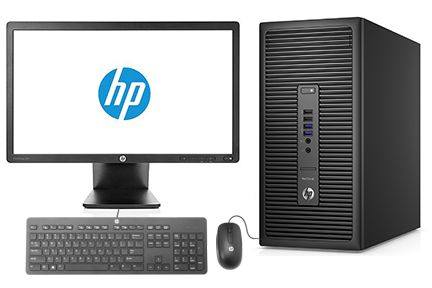Office Buyers Guide
What to consider:
● Deciding between a laptop or a desktop computer is the first step in choosing a computer that suits your office environment.
● A desktop is more suited for larger offices where professional work is limited to a desk and office ergonomics is a major focus.
● A laptop is more suited for professional offices where there may not be as much space available or where workers need the flexibility of a portable workstation.
Choosing a system that will fit your technical requirements and budget:
● If all you require is a system that can browse the internet, write emails and occasionally use office software (such as Microsoft Word or Excel), then an entry-level computer should suffice. This is the cheapest option, however it may n ot always be suitable for a professional office environment.
● If you require a system which will be using a range of basic programs (such as the Microsoft Office suite), then a mid-range computer will be the perfect all-rounder PC for you. This is a step up from the entry-level option and should fit the requirements of most working offices.
● If you require a system that can handle intensive programs used in audio/video editing, 3D rendering, development and programming, then a high-end system is a necessity. These are designed for professional offices working with high-end software where the best performance is required.
Which CPU should you choose?
● The two major manufacturers of CPUs are currently Intel with their Intel Core selection and AMD with their Ryzen selection. Both companies currently offer great options to suit any workload and have models to suit any budget.
● Intel Core i3 and Ryzen 3 are the introductory models and are suited for simple workstations that are affordable. These CPUs may begin to struggle if doing more than web browsing, emailing and running simple office suite programs. They are generally not ideal at running all these programs at the same time and therefore may limit multitasking ability and productivity.
● Intel Core i5 and Ryzen 5 are the mid-range options and offer good performance in most situations. They will typically allow you to run multiple programs at once and therefore allow for more productivity when compared to the Core i3 and Ryzen 3.
● Intel Core i7 and Ryzen 7 typically have better performance than the Intel Core i5 and Ryzen 5 due to more cores and a higher clock speed. They are suited for systems that are required to run more intensive programs such as those used for video and image editing, 3D modelling, gaming and programming.
● Intel Core i9 and Ryzen 9 are the enthusiast grade offerings of both companies and give extremely high performance for high-level gaming, multi-tasking, professional video/audio editing and 3D rendering.
The key components of a computer
● The CPU acts like the brain of the system. It runs all programs, calculations and operations. A computer cannot function without one.
● Generally, the higher the clock speed (GHz), the faster the CPU. The more cores, the better the performance and multi-tasking capabilities.
● Look for a CPU with a high clock speed and high number of cores if you plan on running demanding software, running multiple tasks at once or playing intensive games.
● When looking at a CPU, the major manufacturers are Intel and AMD. Both companies have a number of great options to suit any budget and workload. Intel offers the Intel Core series, whilst AMD offers the Ryzen series.
● The graphics card creates the image on the screen and is generally only necessary for gaming, video editing, graphics design and 3D rendering.
● You may need a dedicated graphics card if you want to use multiple monitors but your motherboard only has limited display connections, or in cases when a CPU does not support integrated graphics at all.
● The core clock and the memory size of the graphics card are the two most important factors to look at when purchasing.
● RAM stores small amounts of data but transfers it at extremely high speeds.
● Aim for at least 8gb of RAM for everyday use. This amount will allow for comfortable multitasking whilst using simple programs. 16gb of RAM should be considered if you plan on using two monitor screens and use multiple programs at once.
● For intense video/audio editing software, programming or 3D rendering, 32gb may be required to get the best performance.
● When considering a storage device, think whether a Solid-State Drive (SSD) or a Hard Disk Drive (HDD) suits your needs.
● An SSD generally has high speeds but smaller storage amounts while a HDD will have high storage amounts but slow speeds. This means that SSDs are typically more expensive than HDDs.
● If your operating system is installed on an SSD, it will allow for extremely fast boot up times and data transfer speeds.
If more space is required, consider an external storage device for your system. This will allow you to back up important documents and save any additional files.
